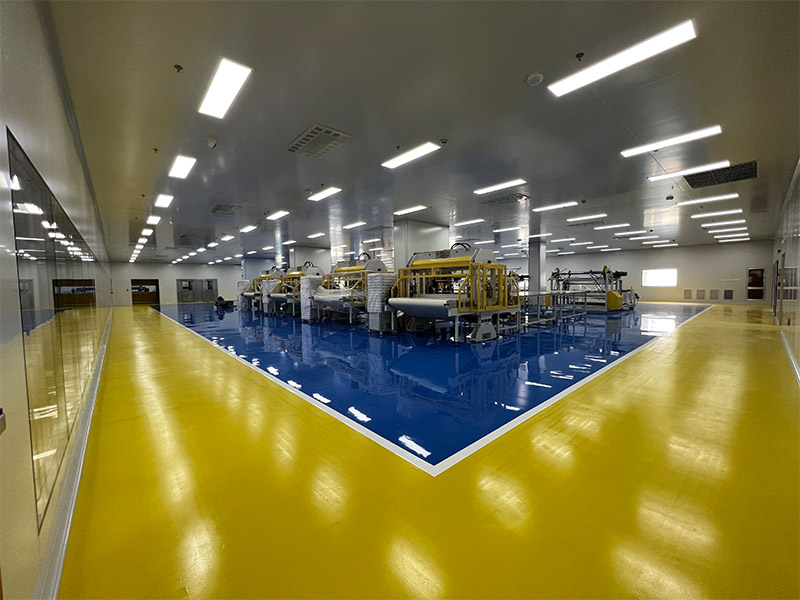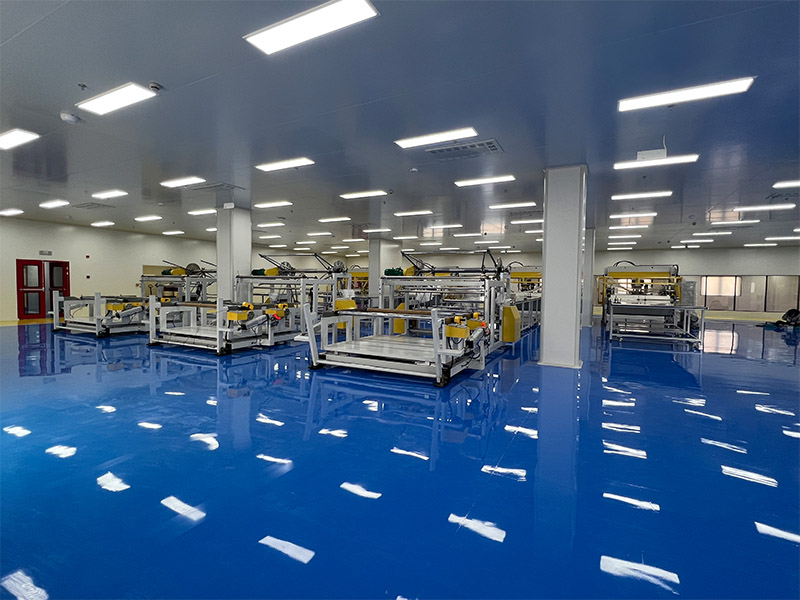

In modern fast-paced life, cosmetics are indispensable in people's lives, but sometimes it may be because the ingredients of the cosmetics themselves cause the skin to react, or it may be because the cosmetics are not cleaned during processing. Therefore, more and more cosmetics factories have built high-standard clean room, and the production workshops have also been dust free, and the dust free requirements are very strict.
Because clean room can not only ensure the health of the staff inside, but also play a significant role in the quality, accuracy, finished product and stability of the products. The quality of cosmetics production depends largely on the production process and production environment.
In summary, clean room is crucial to ensuring the quality of cosmetics. This specification helps to build dust free clean room for cosmetics that meet standards and regulate the behavior of production personnel.
Cosmetics management code
1. In order to strengthen the hygienic management of cosmetics manufacturing enterprises and ensure the hygienic quality of cosmetics and the safety of consumers, this specification is formulated in accordance with the "Cosmetics Hygiene Supervision Regulations" and its implementation rules.
2. This specification covers the hygienic management of cosmetics manufacturing enterprises, including cosmetics manufacturing enterprise site selection, factory planning, production hygiene requirements, hygienic quality inspection, storage hygiene of raw materials and finished products, and personal hygiene and health requirements.
3. All enterprises engaged in cosmetics production must comply with this specification.
4. The health administrative departments of local people's governments at all levels shall supervise the implementation of these regulations.
Factory site selection and factory planning
1. The location selection of cosmetics manufacturing enterprises should comply with the municipal overall plan.
2. Cosmetic manufacturing enterprises should be built in clean areas, and the distance between their production vehicles and toxic and harmful pollution sources should be no less than 30 meters.
3. Cosmetic companies must not affect the life and safety of surrounding residents. Production workshops that produce harmful substances or cause serious noise should have appropriate sanitary protection distances and protective measures from residential areas.
4. The factory planning of cosmetics manufacturers should comply with hygienic requirements. The production and non-production areas should be set up to ensure production continuity and no cross-contamination. The production workshop should be placed in a clean area and located in the local dominant upwind direction.
5. The layout of the production workshop must meet the production process and hygiene requirements. In principle, cosmetics manufacturers should set up raw material rooms, production rooms, semi-finished product storage rooms, filling rooms, packaging rooms, container cleaning, disinfection, drying, storage rooms, warehouses, inspection rooms, change rooms, buffer zones, offices, etc. to prevent cross-over pollute.
6. Products that generate dust during the production process of cosmetics or use harmful, flammable, or explosive raw materials must use separate production workshops, special production equipment, and have corresponding health and safety measures.
7. Waste water, waste gas, and waste residue must be treated and meet the relevant national environmental protection and health requirements before they can be discharged.
8. Auxiliary buildings and facilities such as power, heating, air conditioning machine rooms, water supply and drainage systems, and wastewater, waste gas, and waste residue treatment systems should not affect the hygiene of the production workshop.
Hygiene requirements for production
1. Cosmetics manufacturing enterprises must establish and improve corresponding health management systems and equip themselves with professionally trained full-time or part-time health management personnel. The list of health management personnel shall be reported to the health administrative department of the provincial people's government for record.
2. The total area of the production, filling and packaging rooms shall not be less than 100 square meters, the per capital floor space shall not be less than 4 square meters, and the clear height of the workshop shall not be less than 2.5 meters.
3. The floor of clean room should be flat, wear-resistant, non-slip, non-toxic, impermeable to water, and easy to clean and disinfect. The floor of the work area that needs to be cleaned should have a slope and no water accumulation. A floor drain should be installed at the lowest point. The floor drain should have a bowl or grate cover.
4. The four walls and ceiling of the production workshop should be lined with light-colored, non-toxic, corrosion-resistant, heat-resistant, moisture-proof, and mildew-proof materials, and should be easy to clean and disinfect. The height of the waterproof layer shall not be less than 1.5 meters.
5. Workers and materials must enter or be sent to the production workshop through the buffer zone.
6. The passages in production workshop should be spacious and unobstructed to ensure transportation and health and safety protection. Items unrelated to production are not allowed to be stored in the production workshop. Production equipment, tools, containers, sites, etc. must be thoroughly cleaned and disinfected before and after use.
7. Production workshops with visiting corridors should be separated from the production area by glass walls to prevent artificial contamination.
8. The production area must have a change room, which should have wardrobes, shoe racks and other changing facilities, and should be equipped with running water hand washing and disinfection facilities; the production enterprise should set up secondary change room according to the needs of the product category and process.
9. Semi-finished product storage rooms, filling rooms, clean container storage rooms, changing rooms and their buffer areas must have air purification or air disinfection facilities.
10. In production workshops that use air purification devices, the air inlet should be far away from the exhaust outlet. The height of the air inlet from the ground should be no less than 2 meters, and there should be no pollution sources nearby. If ultraviolet disinfection is used, the intensity of the ultraviolet disinfection lamp shall not be less than 70 microwatts/square centimeter, and shall be set at 30 watts/10 square meters and hoisted 2.0 meters above the ground; the total number of bacteria in the air in the production workshop shall not exceed 1,000/cubic meter.
11. The production workshop of clean room should have good ventilation facilities and maintain appropriate temperature and humidity. The production workshop should have good lighting and lighting. The mixed illumination of the working surface should not be less than 220lx, and the mixed illumination of the working surface of the inspection site should not be less than 540lx.
12. The quality and quantity of production water should meet the requirements of the production process, and the water quality should at least meet the requirements of the sanitary standards for drinking water.
13. Cosmetics manufacturers should have production equipment that is suitable for product characteristics and can ensure the hygienic quality of products.
14. The installation of fixed equipment, circuit pipes and water pipes of production enterprises should prevent water droplets and condensation from contaminating cosmetic containers, equipment, semi-finished products and finished products. Promote enterprise production automation, pipelines, and equipment sealing.
15. All equipment, tools, and pipes that come into contact with cosmetic raw materials and semi-finished products must be made of non-toxic, harmless, and anti-corrosion materials, and the inner walls should be smooth to facilitate cleaning and disinfection. The cosmetics production process should be connected up and down, and the flow of people and logistics should be separated to avoid crossover.
16. All original records of the production process (including inspection results of key factors in the process procedures) should be properly preserved, and the storage period should be six months longer than the shelf life of the product.
17. The cleaning agents, disinfectants and other harmful items used should have fixed packaging and clear labels, be stored in special warehouses or cabinets, and be kept by dedicated personnel.
18. Pest control and pest control work should be carried out regularly or when necessary in the factory area, and effective measures should be taken to prevent the gathering and breeding of rodents, mosquitoes, flies, insects, etc.
19. The toilets in production area are located outside workshop. They must be water-flush and have measures to prevent odor, mosquitoes, flies and insects.
Health quality inspection
1. Cosmetic manufacturing enterprises shall establish hygienic quality inspection rooms that are compatible with their production capacity and hygienic requirements in accordance with the requirements of cosmetics hygienic regulations. The health quality inspection room should be equipped with corresponding instruments and equipment, and have a sound inspection system. Personnel engaged in health quality inspection must receive professional training and pass the assessment of the provincial health administration department.
2. Each batch of cosmetics must undergo hygienic quality inspection before being put on the market, and can only leave the factory after passing the test.
Hygiene requirements for storage of raw materials and finished products
3. Raw materials, packaging materials and finished products must be stored in separate warehouses, and their capacity should be compatible with production capacity. The storage and use of flammable, explosive and toxic chemicals must comply with relevant national regulations.
4. Raw materials and packaging materials should be stored in categories and clearly labeled. Dangerous goods should be strictly managed and stored in isolation.
5. Finished products that pass the inspection should be stored in the finished product warehouse, classified and stored according to variety and batch, and must not be mixed with each other. It is prohibited to store poisonous, hazardous items or other perishable or flammable items in the finished product warehouse.
6. Inventory items should be stacked away from the ground and partition walls, and the distance should not be less than 10 centimeters. Passages should be left, and regular inspections and records should be made.
7. The warehouse must have ventilation, rodent-proof, dust-proof, moisture-proof, insect-proof and other facilities. Clean regularly and maintain hygiene.
Personal hygiene and health requirements
1. Personnel directly engaged in cosmetics production (including temporary workers) must undergo a health examination every year, and only those who have obtained a preventive health examination certificate can engage in cosmetics production.
2. Employees must undergo health knowledge training and obtain a health training certificate before taking up their posts. Practitioners receive training every two years and have training records.
3. Production personnel must wash and disinfect their hands before entering the workshop, and wear clean work clothes, hats, and shoes. The work clothes should cover their outer clothes, and their hair must not be exposed outside the hat.
4. Personnel who are in direct contact with raw materials and semi-finished products are not allowed to wear jewelry, watches, dye their nails, or keep their nails long.
5. Smoking, eating and other activities that may hinder the hygiene of cosmetics are prohibited in the production site.
6. Operators with hand injuries are not allowed to come into contact with cosmetics and raw materials.
7. You are not allowed to wear work clothes, hats and shoes from the production workshop of clean room into non-production places (such as toilets), and you are not allowed to bring personal daily necessities into the production workshop.
Post time: Feb-01-2024

